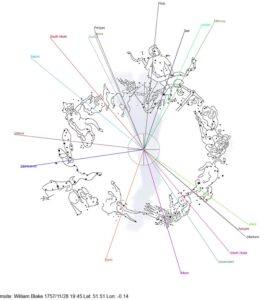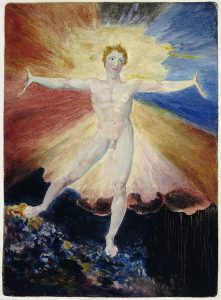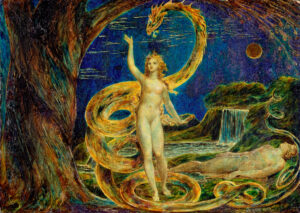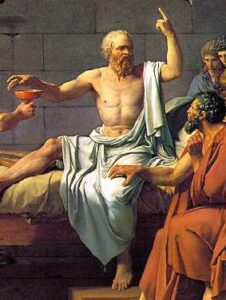Biography
The unit on NARRATIVE presents a series of cameos of famous people known for their enduring contributions in diverse fields from engineering to the arts. Each cameo is not a complete decoding of the manifold — which would run to many pages. Rather, it is a selection of entries that demonstrate how the accomplishments of the exemplars mirror specific code-lines in their manifold. Remember, when you look at your own manifold or an exemplar, you are prompting the code to show you a genomic match. The free-access material on this page presents a cameo of visionary artist and poet, William Blake.
The Prodigal Son of Albion
I have often said in decades of teaching how to read and apply the celestial script: “If you don’t use your imagination, someone else will.” To be more precise, if you do not own it and exercise it in the right way, other forces will co-opt it. In The Emanation of the Giant Albion, English poet and mystic, William Blake, wrote: “I must create a system, or be enslaved by another man’s. I will not reason and compare: my business is to create.” Blake lived up to that credo by creating how own system of mythology, proven in the enduring influence of his life-work today, even though he was not recognized for it in his own time. But Blake’s credo is rather presumptive. I assure you that no one creates a system from scratch, out of thin air. Blake drew from pre-existing themes and images in the star-pointed panorama of mythic animations.
No artist, write, inventor, or religious teacher has ever originated anything in the absolute sense. At best, what is primordially there can be reworked and expressed in an original way. To originate does not mean doing something never done before. It means, treating what already is there in an original way. It means working from origins.

Blake’s manifold projected into the Rimsite shows the 16 asset/skills he applied to creative expressions in each of 16 regions of proof. Forensic astronomy looks at the evidence of how each asset developed for the purpose of creative expression. Look at this code-line:
Saturn asset > trajectory of purpose > tail of the Goatfish.

How can you decode the Saturn line in Blake’s manifold so that you detect a genomic match with his creative accomplishment? Blake applied his Saturn asset (social conscience, moral responsibility) to the mythical meme “tail of the Goatfish” which designates the deathless thrust of the life-force flowing through many generations, called elan vital by the French philosopher Henri Bergson. Elan vital is an irrepressible leaping force of youthfulness and joy depicted in many of Blake’s paintings and in poems such as the Songs of Innocence.
On right: The Joy of Albion, water color by William Blake.
Success in the way he handled that asset was not restricted to it, however. The Rimsite shows another prime algorithm: Mars >head of the Lion. What is one of the much-beloved poems of Blake, perhaps the best known? Tyger, Tyger, Burning Bright. Mars burns bright in the mane of the celestial Lion. That is biographic evidence that Blake fulfilled his manifold. He did so by complementing the Saturn/Goatfish trope with the themes of the Lion: ancestral nobility, heroic blood, spiritual aristocracy. Acting on his social incentive :: Mars, he defiantly portrayed his native land as an heroic figure, Albion. He inspired the English people to rediscover the nobility of their origins by celebrating their indigenous racial identity in his poetic narratives.

http://www.artuk.org/artworks/eve-tempted-by-the-serpent-30579
This painting of a divine female figure entwined in the coils of a serpent demonstrates a genomic match to a code-line in Blake’s Rimsite: Pluto > Snaketamer. The shaman wrestling the serpent can be male or female but the serpent power itself is universally regarded as feminine. In Gnostic teaching, the serpent in Eden did not tempt Eve to commit sin, it enlightened her by Gnosis. Blake was deeply influenced by the Gnostic themes available in a limited range of sources in his time, including the writings of Thomas Taylor on the Bacchic and Dionysian Mysteries.
“In the last section of Where the Wasteland Ends, Theodore Roszak sets out his view of ‘how the Romantic artists rediscovered the meaning of transcendent symbols and thereby returned western culture to the Old Gnosis, and what part the rhapsodic intellect must play in our journey to the visionary commonwealth’ (p 274). Among the Romantics he cites, the first and foremost is English poet and artist, William Blake, who championed imagination as humankind’s divine faculty.” (From Seven Classics on Nemeta.org.)
Blake recovered and revised the “Old Gnosis,” the wisdom of the Serpent Power. And it doesn’t stop there. Another vector in Blake’s trajectory of purpose is Jupiter > head of the Scorpion, with the Sun close to the heart-star, Antares. This zodiacal engram, observable in the sky and mirrored in human neural programming circuits, designates the “race-romantic ethos.” Blake belonged to the Romantic Movement of the late 18th, early 19th centuries. He was a social revolutionary (Plutonic asset) whose political dissent put him at risk with the authorities of the time. The Race-romantic ethos of the Scorpion is a powerful compulsion to romanticize one’s racial heritage and celebrate one’s ancestral legacy legitimately on the grounds of its achievements, exactly as Blake did. In every manifold the zodiacal engram of the Sun indicates “the myth you live, how you envision the adventure of living.” Sun > heart of the Scorpion perfectly fits the visionary passion of William Blake.
Finally, look at Uranus :: originality, innovation> under the body of Western Fish (futuristic narratives), swimming into the waters that flow from the urn of the Manitu. The Eastern Whale represents the throwback to the distant past and ancient sources of wisdom and guidance. The Western Whale represents Modernity (since 1820) and the collective thrust of civilization toward the future. The trajectory ahead cannot be clear and certain without tools of guidance and new forms of wisdom that insure that humanity can hold to the right course and achieve its highest potential. The media of the visual arts, poetry, and especially cinema are the most influential and promising genres for collective guidance. Blake’s originality :: Uranus was not recognized in his time but only later — i.e., in the future. It can also be said that he was already living in the future, creatively speaking.
This is but one of a dozen other lines that can be decoded. A complete readout of all prime algorithms would easily run to thirty screen-pages here, and twice that to include the body of biographic evidence. This and other cameos will highlight selected code-lines in the manifold to demonstrate how to detect a genomic match. You can learn from exemplars how to compose your life-narrative so that you see the genomic matches in play in the celestial code.
Manifold of Socrates

Classical portrayal of the death of Socrates by Jacques-Louis David (1787). This is a staged scene that assumes that Socrates drank the hemlock at the academy of Plato in the presence of Plato’s students. In reality, he did it in a cave on a hill in Athens below the Parthenon in the company of a small handful of close friends. The gesture of pointing can be read as the painter’s allusion to a well-known claim that established Socrates’ reputation in his time: He is said to have brought philosophy from the heavens (abstraction) down to earth (common sense). Socrates, along with Marcus Aurelius and Nietzsche, are the three foremost historical mentors of Celestics.
Biographic Sampling
